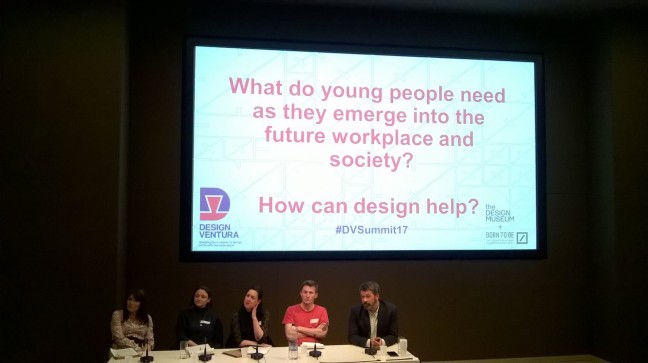
Design Ventura Summit Adventures

The Design Ventura summit “Design: the problem and the solution” was held on 29 March 2017. Its purpose was to bring together educators, designers, cultural providers and policy makers to discuss how they can ensure that young people are developing creativity, design thinking and employability skills to prepare them for future success.
The following extract is by Sarah Campbell, Head of Learning Programmes at the Victoria and Albert Museum and her take on the issues discussed.
Last week, the Design Museum hosted a one-day event as part of their Design Ventura(DV) programme, a ‘design and enterprise challenge for students in years 9, 10 and 11, supported by industry professionals’. The museum invited ‘DV stakeholders’ to participate in a series of talks and workshops exploring the following topic: ‘Design: the problem and the solution (and the imperative for 21C design education)’. It was a fascinating day, not least because a large majority of the audience didn’t work in museums or galleries. The delegates were predominantly teachers and designers, and we talked a lot about how their worlds intersect. The subjects we covered included: improving the relationship between education and industry; access to tech training for teachers; the rising trend of ‘design entrepreneurship’; and the skills that young people need for future employment. For this post, I’ve compiled some of my favourite interesting bits from the day – not an easy task as the whole day was made up of interesting bits – if the Design Ventura Summit had been a chocolate-chip cookie, it would have been made entirely of chocolate.
The Summit was particularly timely too. The day before, the new Chair of Arts Council England, Nick Serota, announced a new commission that will identify how young people benefit from an arts education and strategies for improving current provision. Hopefully, they will build on the myriad of existing reports on the subject, not least ImagiNation: the value of cultural learning, commissioned by the Cultural Learning Alliance and published only a few months ago. The Summit also coincided with the day that the UK Government triggered Article 50, marking the official beginning of divorce proceedings from the European Union. This particular cloud cast quite a long shadow over the event, and the potential negative impact of Brexit on the creative industries was raised a few times. And finally, as I was eating my breakfast earlier that morning and listening to the radio, I heard the news that UK schools are working with ever-diminishing budgets which will result in £3 billion cuts by 2019/20. My first thoughts were with teachers and how grim the work of head teachers will be to balance the books. My second thoughts were, naturally, concerned with museum and gallery education. I suspect school trips will be the first item cut from school budgets (who can blame them?) and this will leave our current model of schools’ provision, focused on site visits, high and dry. It doesn’t matter how great our museum learning programmes are, they ain’t worth much if schools can’t afford to get to us.
With all of these issues swirling around in the background, it was useful to take a design perspective on the confluence of education, policy, and the creative industries. NESTA have been very active in this area and have produced a number of useful reports, including:
- The Fusion Effect (2016): this is NESTA’s take on the STEAM agenda, looking at how the arts and sciences can work together more effectively;
- Creativity Vs Robots (2015): how can anyone resist a title like that? This report looks at the future of jobs and what aspects of work are likely to become automated. A recent Guardian article, ‘Science classes won’t future-proof our children. But dance might’, made reference to PricewaterhouseCooper’s prediction that 30% of British jobs will be lost to automation by the 2030s. Fortunately, artificial intelligence still can’t compete with our human creative capacity, so we’ll remain one step ahead of C3PO for a bit longer.
- Solved! Making the Case for Collaborative Problem-Solving (2017): another title that speaks for itself. ‘Problem-solving’ was definitely one of the day’s key words: it was used as a shorthand definition of design; and it was also name-checked as a 21st century core competency, an attribute valued by employers across a range of industries.

Brexit and the EBacc – a pairing that sounds more like a novelty music act from the 1970s than a confluence of misfortunes – were subjects that couldn’t be avoided. The Government’s Industrial Strategy Green Paper came up in discussion a few times. Published in January, it sets out planning for the UK’s economic future once we have left the EU. Organised around 10 pillars, the ‘developing skills’ priority was considered pertinent to design education and its value to the economy. One speaker also mentioned Brexit Design Manifesto, produced by Dezeen magazine, which is worth a look.
The sharp decline in pupils studying Design and Technology at GCSE level was a particular cause for concern during discussions. The Design and Technology Association (DATA) spearheaded a campaign last year to raise the profile of the subject. Their short film What is Design & Technology – and why do we need it?, made a connection between the investment in D&T in the 1990s and the pay-off over the following decades as those pupils then thrived and built careers in the creative industries. We risk cutting off the pipeline of new talent when design (either through D&T or Art & Design) is cut from a child’s education.
So far, so sadly familiar – the drop in D&T has been a topic of discussion for some time now. What I found more interesting was hearing another perspective on the issue. Holly Donagh from A New Direction framed the EBacc discussion in relation to inclusion agendas. Pupils who graduate with at least five GCSEs will go on to have greater social mobility and more career opportunities than those who don’t. The aim of the EBacc is to get 90% of pupils achieving five GCSEs; whereas the current figure is closer to 35-40%. Living in my leftie echo-chamber, I only ever hear about how awful the EBacc is. Of course it makes sense that those on the other side of the fence also want a high quality education for the next generation – we just have very different views on the role of art and design in achieving that (I should add that Holly was presenting another perspective for the purposes of a group discussion, rather than arguing against design education). Both sides in this debate are deeply entrenched and Holly’s comments made me realise that a greater insight into each other’s rationale would surely help find some middle ground.
And finally, there was plenty of discussion around career pathways for young people. It’s one thing to be at school, and it’s another thing to be established in a career – but getting from A to B is incredibly daunting when you’re 16 and don’t know what you want to do with your life. A huge range of jobs rely on creative skills, and the creative industries are stuffed with a variety of careers, but these opportunities are not well-known. If young people (and their parents) were better informed about what was possible and available, the value of design education would be better understood. The Sorrell Foundation has created the online resource, Creative Journeys, to meet just that purpose. And I should also mention Creative Quarter and Making It are two large careers’ festivals for young people that the V&A’s Learning department run each year.
Another of NESTA’s projects involves sifting through a mountain of online job advertisements to identify the careers that require creative skills. They have sifted through 33 million online ads (promoting UK jobs, dating from 2011-16) and identified 12,000 unique skills. From this data, they have arranged creative skills into five broad categories – Tech, Support, Selling, Creating & Designing, and Teaching. The final resource is still being tested, but it will ultimately provide an online facility whereby a young person can identify their skills and interests and match them to a range of possible career options.
The jobs-market isn’t what it used to be. My own career pathway – from administrator to assistant education officer to education officer to management – feels very old-fashioned when I read the CVs of twenty-somethings, dominated by internships, volunteering, placements and short-term contracts. A patchwork of experience now seems to be the norm. Perhaps not surprisingly, initiative and drive are key attributes in this working climate, and the top buzzword of the day – entrepreneurship – is becoming increasingly important.
Julio Terra from Kickstarter gave one of the keynotes and offered great insights into this new world of work. He recommended designer Craighton Berman and his interest in ‘design entrepreneurship’, championing how designers can work more independently and sustainably. Julio also mentioned ‘D2C’, the designer-to-consumer model, made possible through digital technologies that cut out the middlemen of distribution. And of course Kickstarter itself is changing the game for how new products are backed and launched. I can’t quite believe the company was founded as recently as 2009 – it feels like it’s always been there. In this model, storytelling and narrative have usurped conventional marketing. Young designers are attracting backers through engaging and personal short films to promote their work, made using readily available software.
This brave new world of employment has a rich assortment of pitfalls and opportunities, many of which – for good and bad – are the result of new technologies and a splintered job market. While we need new thinking around education and training to keep abreast of these rapid changes, the path to success remains the same – find something you’re passionate about, word hard, network, and be good at what you do.
Source: https://kiwilooseinmuseums.wordpress.com/2017/04/03/design-ventura-summit-adventures/
